Masutomi Castle
-One day siege and one day build (2)-
Overview
Name: Masutomi castle (Masutomi-jo)
Alias:
Place: Nakamasu Kama city, Fukuoka
Location: 33.546779739140696, 130.75058635365787
Type: Mountain Castle
Built: Around 1430
Remaining remnants: Gates (transferred), stone walls, clay walls and dry moats
Title:
Masutomi castle, also called as Okuma castle (益富城, 大隈城), is located at the top of Masutomi-yama mountain, one of about 150 meter height from hillside at the backside of Okuma town in the center of current Kama city. Kama area is at the south edge of hilly basin around the upstream of Onga-gawa river flows from Chikushi mountains toward current Kitakyushu city coast.
Castle site is a crossing point of current Route 211 which runs northeast and southwest ward from Kitakyushu area to Hita basin of Bungo province (Oita prefecture), and Route 322 from coastal area of Suonada bay to Kurume area through Akizuki area. Because of this geographical condition, Kama area has been an important point communication in the eastern part of Chikuzen province (northwestern part of Fukuoka prefecture).
It is said that Masutomi castle was built by Moriharu Ouchi (1377-1431), the leader of Ouchi clan around 1430. Ouchi clan was a traditional local lord of Suo province which insisted as an descendant of local family of disappeared Korean Baekje kingdom, and grew as a local lord since 10th century. At the establishment of Kamakura Shogunate, Ouchi clan supported Yoshitomo Minamoto (1147-1199) and became the retainer of Shogunate.
After the fall of Kamakura Shogunate, Hiroyo Ouchi (1325-1380) once belonged to South Court established by Emperor Godaigo (1288-1339) and expanded his territory toward Nagato province but later turned to Muromachi Shogunate. Hiroyo supported Ryoshun Imagawa (1326-1420) who was appointed as a general commander of Muromachi Shogunate at Kyushu island, and Muromachi Shogunate army captured major part of Kyushu island defeating South Court army by 1390.
However, Yoshimitsu Ashikaga (1358-1408), the third Shogun who feared the power of strong warlords, dismissed Ryoshun Imagawa. Yoshihiro Ouchi (1356-1400), the son of Hiroyo, once supported Yoshimitsu and expanded his territory, but finally was suppressed by Yoshimitsu then raised his army but failed and died in the battle.
But Moriharu Ouchi who was the younger brother of Yoshihiro and survived this accident succeeded Ouchi clan and expanded into Kyushu island fighting against Shoni clan or Otomo clan. Moriharu proceeded into eastern part of Chikuzen province built Masutomi castle as his regional base, but soon died in the battle against Shoni clan and Otomo clan.
In spite of the death of the leader, Ouchi clan continued its expansion toward Kyushu island, and once captured Chikuzen province around the middle of 15th century. When Otomo army made expedition to Kinki region at the battle of Onin from 1467 to 1477, Shoni clan and Otomo clan attacked Chikuzen province and captured it. But after return, Otomo clan attacked Shoni clan and once ruined it. For a while, Masutomi castle might be kept under Ouchi clan.
Ouchi clan prospered as a wealthy and strong warlord in the former half of 16th century, but suddenly fell by the incident of Daineiji, a coup d'?tat by their general Harukata Sue (1521-1555). Yoshishige Otomo (1530-1587), the leader of Ouchi clan, supported Harukata in exchange of the territory of Ouchi clan at Kyushu island, then Otomo clan once captured Masutomi castle.
But on the other hand, Motomari Mouri (1497-1571), the warlord of Aki province (Hiroshima prefecture) who beat Harukata Sue at the battle of Itsukushima and succeeded the territory of Ouchi clan, proceeded into Kyushu island and tried to recover former Ouchi territory. In 1560, Mouri clan which captured Moji castle at the entrance of Kyushu island fiercely fought with Otomo army and once captured Masutomi castle, then placed their retainer as a commander.
Mouri clan and Otomo clan continued conflict for Hakata area over 10 years, and once Mouri clan became superior by letting important retainers of Otomo clan such as Akitane Takahashi (1529-1579) who was the lord of Homanyama castle or Akitoshi Tachibana (?-1568) at Tachibanayama castle to rebel against Otomo clan. But by the desperate attack of Otomo army lead by its excellent general Dosetsu Tachibana (1513-1585), Otomo clan pushed out Mouri army from Chikuzen province.
Otomo clan prospered as the ruler of north half of Kyushu region, but started to decline after the defeat at the battle of Mimikawa against Shimazu clan in 1578. Looking at this opportunity, Tanezane Akizuki (?-1596) who was the lord of Koshosan castle (Fukuoka prefecture) at the inside of Kama area rapidly grew into a strong warlord of the area.
Akizuki clan was a traditional local lord stem from central noble Haruzane Okura (?-?), who subjugated the rebellion of Sumitomo Fujiwara (?-941) in 10th century. Akizuki clan originally belonged to Ouchi clan, but after the fall of Ouchi clan once followed to Otomo clan.
But in 1557, Fumitane Akizuki (1512-1557), the leader of Akizuki clan, left Otomo clan and turned to Mouri clan which was the warlord of Aki province (Hiroshima prefecture) and proceeded into north part of Kyushu island. But this time Otomo clan attacked Koshosan castle with dominant army and Akizuki clan once ruined.
Later Tanezane Akizuki (?-1596),who was the son of Fumitane and survived the battle, returned to former territory and restored the clan. Tanezane once belonged to Otomo clan, but looking at the rebel of important generals of Otomo clan such as Akitane Takahashi (1529-1579) who was the lord of Homanyama castle or Akitoshi Tachibana (?-1568) at Tachibanayama castle under the support of Mouri clan, Tanezane also raised against Otomo clan. But this time Otomo clan finally suppressed these rebellion after tough battles, and Tanezane surrendered to Yoshishige Otomo.
However, looking at the fall of Otomo clan at the battle of Mimikawa in 1578, Tanezane allied with Shimazu clan and captured neighbor territory of Otomo clan. Being defeated several time before Dosetsu Tachibana (1513-1585), an excellent general of Otomo clan, Tanezane increased his territory around Buzen province by sending his son as successors of Takashi clan or Nagano clan. After the death of Dosetsu, Otomo clan could not protect their territory any more, and Tanezane had a vast territory.
Around 1580 Tanezane used Masutomi castle as retirement place, but Tanezane still kept his authority and it was a substantial move of main base from Koshosan castle. Territory of Akizuki clan significantly expanded into northeast ward, and Koshosan castle at high mountain in deep valley was inconvenient to cope this.
In 1586, Shimazu army made total attack against Otomo clan, and Otomo clan was forced to the corner, Tanezane attacked Iwaya castle protected by Jyoun Takahashi (1548-1586), a colleague of Dosetsu, along with Shimazu army. Shimazu army and Akizuki army fell Iwaya castle after a fierce battle, and capture of Hakata area was close at hand. Next Shimazu army and Akizuki army siege Tachibanayama castle which was kept by Muneshige Tachibana (1567-1643), son of Jyoun and adopted son of Dosetsu.
However, central ruler Hideyoshi Toyotomi (1537-1598) who was asked to rescue Otomo clan started Kyushu campaign against Shimazu clan. Vanguard of Toyotomi clan landed to Kyushu island, then Shimazu army released siege of Tachibanayama castle and retreated. Akizuki army was defeated by counter attack of Muneshige, and in turn Akizuki clan was exposed to strong enemy.
In 1587, at last main force of Hideyoshi with 200,000 soldier landed to Kyushu island., and many local lords at north part of Kyushu island turned to Hideyoshi. As detached force lead by Hidenaga Toyotomi (1540-1591) already released Bungo province and intruded into Hyuga province (Miyazaki prefecture), Hideyoshi planned to proceed to Higo province through current Kurume area with his main force. Akizuki clan and Ganjaku castle (Fukuoka prefecture) at the border became the first target of Hideyoshi.
On April 1, 1587, Hideyoshi ordered his army lead by his nephew Hidekatsu Hashiba (1569-1592), Ujisato Gamo (1556-1595) and Toshinaga Maeda (1562-1614) to siege Ganjaku castle. Akizuki army desperately fought, but being overwhelmed by thousands of enemy, Ganjaku castle fell only in one day. In spite of its highness, there are many climbing route to the castle and the castle could not bear saturation attack from many directions.
Tanezane Akizuki knew the fall of Ganjaku castle only in one day disposed Masutomi castle and retreated to his main base Koshosan castle at incredibly higher place as a main base of large lord. But next day Hideyoshi advanced to destructed Masutomi castle let the local people make bonfire here and there, then ordered them to bring their doors and partitions to the castle.
Hideyoshi assembled these doors and partitions into fake castle and showed it to Akizuki army. He also flow abundant rice from sidewall of central area, as if he had plenty water.
This performance of short building is a favorite tactics of Hideyoshi, also shown in Sunomata castle (Gifu prefecture) or Ishigakiyama castle (Kanagawa prefecture).
Looking at this one day fall of Ganjaku castle and one day build performance, Tanezane Akizuki lost his will and surrendered to Hideyoshi, by giving his treasured tea were named as "Narashiba". Hideyoshi gave his mantle to local people and it still remains now.
After the battle, Akizuki clan was moved to Hyuga province (Miyazaki prefecture) thus Ganjaku castle became the branch castle of Takakage Kobayakawa (1533-1597) who became the magistrate of Hakata city.. After the battle of Sekigahara in 1600, Chikuzen province was given to Nagamasa Kuroda (1568-1623). Masutomi castle was kept as one of the six branch castles of Kuroda cla including Wakamatsu castle, Kurosaki castle, Takatoriyama castle, Masutomi castle, Matsuo castle and Matera castle, and was reformed into a secure fortress.
Fukuoka castle which was a main base of Kuroda clan located western end of the province, and Kama area was separated by mountains from Fukuoka area. Masutomi castle was planned to be the center of six border castles and extremely large among them. Nagamasa placed his most brave general Mototsugu Goto (1560-1615, famous as Matabe Goto) as the commander of the castle.
Main body of the castle spreads a narrow and long ridge of the mountain spread north and south ward. Central area of the castle is a long and narrow rectangular terrace of 100 meter long and 20 meter width, having a small watchtower base at its north end. Main gate of the area at the next of basement is a magnificent Masugata style one, and there are several barrack turrets along with the side wall.
Secondary area is same size and shape area at the south of central are, also has a Masugata style gate at its south end. On the other hand, at the north of central area, there is a ruin of terraces called as stables protected by old style stone walls, which might be built under Akizuki clan. At the eastern hillside, there is a water source area which might be protected by magnificent stone walls also. Wreck of stones are large and well shaped similar to Fukuoka castle, the main base of Kuroda clan, which shows importance of Masutomi castle.
Opposite of the valley at the east side, outer areas still keeps the shape of terrain spreads over the hill. Front forts were built at each corner of the hill, and the residence of the lord was built at southern hillside. Total size of the castle reached to 500 meter long square. and undoubtedly second castle of Kuroda clan.
Mototsugu Goto served as a commander of Masutomi castle but became conflict with his master and left Kuroda clan in 1606. As Kuroda clan disturbed reemployment of Mototsugu, Mototsugu participated in Toyotomi army at the battle of Osaka castle in 1614 and 1615, and finally died in the battle of Domyoji after a fierce battle against Tokugawa army.
After Mototsugu, Tomonobu Mori (1556-1615, famous as Tahe Mori) who was also a brave general and known to achieve famous spear "Nihongo" from Masanori Fukushima (1561-1624) by winning drink match. But Tomonobu died in ill in 1615, and Masutomi castle was also abolished by Ikkoku Ichijo-Rei (one domain one castle rule) at that year.
Now most building was lost but two gates remains at neighbor temples. Stone walls were broken at the time of abolishment, but basement layer was excavated and shows the shape of stone walls well. Utilizing old fact, local people hold festival in autumn and make paper built castle every year. Although apart from Fukuoka or Kitakyushu city area, castle site has a good access by car and its powerful ruins is worth to visit.
60 minutes drive from Kyushu Jidoshado Expressway Yahata interchange via Route 200 and Route 211.
Ganjaku Castle -One day siege and one day build (1)-
Koshosan Castle -One day siege and one day build (3)-
Takanabe Castle -Change for survival-
Sunomata Castle -Created tale of Hideyoshi in youth-
Ishigakiyama Castle -Master of sieging castle-
Fukuoka Castle -Huge castle looking down on commercial city-
Matsuo Castle -Short lived castellum in mountains-
Type: Mountain Castle
Built: Around 1430
Remaining remnants: Gates (transferred), stone walls, clay walls and dry moats
Title:
Brief History
Masutomi castle, also called as Okuma castle (益富城, 大隈城), is located at the top of Masutomi-yama mountain, one of about 150 meter height from hillside at the backside of Okuma town in the center of current Kama city. Kama area is at the south edge of hilly basin around the upstream of Onga-gawa river flows from Chikushi mountains toward current Kitakyushu city coast.
Castle site is a crossing point of current Route 211 which runs northeast and southwest ward from Kitakyushu area to Hita basin of Bungo province (Oita prefecture), and Route 322 from coastal area of Suonada bay to Kurume area through Akizuki area. Because of this geographical condition, Kama area has been an important point communication in the eastern part of Chikuzen province (northwestern part of Fukuoka prefecture).
Origin of Masutomi castle
It is said that Masutomi castle was built by Moriharu Ouchi (1377-1431), the leader of Ouchi clan around 1430. Ouchi clan was a traditional local lord of Suo province which insisted as an descendant of local family of disappeared Korean Baekje kingdom, and grew as a local lord since 10th century. At the establishment of Kamakura Shogunate, Ouchi clan supported Yoshitomo Minamoto (1147-1199) and became the retainer of Shogunate.
After the fall of Kamakura Shogunate, Hiroyo Ouchi (1325-1380) once belonged to South Court established by Emperor Godaigo (1288-1339) and expanded his territory toward Nagato province but later turned to Muromachi Shogunate. Hiroyo supported Ryoshun Imagawa (1326-1420) who was appointed as a general commander of Muromachi Shogunate at Kyushu island, and Muromachi Shogunate army captured major part of Kyushu island defeating South Court army by 1390.
However, Yoshimitsu Ashikaga (1358-1408), the third Shogun who feared the power of strong warlords, dismissed Ryoshun Imagawa. Yoshihiro Ouchi (1356-1400), the son of Hiroyo, once supported Yoshimitsu and expanded his territory, but finally was suppressed by Yoshimitsu then raised his army but failed and died in the battle.
Struggle at Kyushu island
But Moriharu Ouchi who was the younger brother of Yoshihiro and survived this accident succeeded Ouchi clan and expanded into Kyushu island fighting against Shoni clan or Otomo clan. Moriharu proceeded into eastern part of Chikuzen province built Masutomi castle as his regional base, but soon died in the battle against Shoni clan and Otomo clan.
In spite of the death of the leader, Ouchi clan continued its expansion toward Kyushu island, and once captured Chikuzen province around the middle of 15th century. When Otomo army made expedition to Kinki region at the battle of Onin from 1467 to 1477, Shoni clan and Otomo clan attacked Chikuzen province and captured it. But after return, Otomo clan attacked Shoni clan and once ruined it. For a while, Masutomi castle might be kept under Ouchi clan.
Ouchi clan prospered as a wealthy and strong warlord in the former half of 16th century, but suddenly fell by the incident of Daineiji, a coup d'?tat by their general Harukata Sue (1521-1555). Yoshishige Otomo (1530-1587), the leader of Ouchi clan, supported Harukata in exchange of the territory of Ouchi clan at Kyushu island, then Otomo clan once captured Masutomi castle.
Capture and loss by Mouri clan
But on the other hand, Motomari Mouri (1497-1571), the warlord of Aki province (Hiroshima prefecture) who beat Harukata Sue at the battle of Itsukushima and succeeded the territory of Ouchi clan, proceeded into Kyushu island and tried to recover former Ouchi territory. In 1560, Mouri clan which captured Moji castle at the entrance of Kyushu island fiercely fought with Otomo army and once captured Masutomi castle, then placed their retainer as a commander.
Mouri clan and Otomo clan continued conflict for Hakata area over 10 years, and once Mouri clan became superior by letting important retainers of Otomo clan such as Akitane Takahashi (1529-1579) who was the lord of Homanyama castle or Akitoshi Tachibana (?-1568) at Tachibanayama castle to rebel against Otomo clan. But by the desperate attack of Otomo army lead by its excellent general Dosetsu Tachibana (1513-1585), Otomo clan pushed out Mouri army from Chikuzen province.
Otomo clan prospered as the ruler of north half of Kyushu region, but started to decline after the defeat at the battle of Mimikawa against Shimazu clan in 1578. Looking at this opportunity, Tanezane Akizuki (?-1596) who was the lord of Koshosan castle (Fukuoka prefecture) at the inside of Kama area rapidly grew into a strong warlord of the area.
Origin of Akizuki clan
Akizuki clan was a traditional local lord stem from central noble Haruzane Okura (?-?), who subjugated the rebellion of Sumitomo Fujiwara (?-941) in 10th century. Akizuki clan originally belonged to Ouchi clan, but after the fall of Ouchi clan once followed to Otomo clan.
But in 1557, Fumitane Akizuki (1512-1557), the leader of Akizuki clan, left Otomo clan and turned to Mouri clan which was the warlord of Aki province (Hiroshima prefecture) and proceeded into north part of Kyushu island. But this time Otomo clan attacked Koshosan castle with dominant army and Akizuki clan once ruined.
Later Tanezane Akizuki (?-1596),who was the son of Fumitane and survived the battle, returned to former territory and restored the clan. Tanezane once belonged to Otomo clan, but looking at the rebel of important generals of Otomo clan such as Akitane Takahashi (1529-1579) who was the lord of Homanyama castle or Akitoshi Tachibana (?-1568) at Tachibanayama castle under the support of Mouri clan, Tanezane also raised against Otomo clan. But this time Otomo clan finally suppressed these rebellion after tough battles, and Tanezane surrendered to Yoshishige Otomo.
Rise of Akizuki clan
However, looking at the fall of Otomo clan at the battle of Mimikawa in 1578, Tanezane allied with Shimazu clan and captured neighbor territory of Otomo clan. Being defeated several time before Dosetsu Tachibana (1513-1585), an excellent general of Otomo clan, Tanezane increased his territory around Buzen province by sending his son as successors of Takashi clan or Nagano clan. After the death of Dosetsu, Otomo clan could not protect their territory any more, and Tanezane had a vast territory.
Around 1580 Tanezane used Masutomi castle as retirement place, but Tanezane still kept his authority and it was a substantial move of main base from Koshosan castle. Territory of Akizuki clan significantly expanded into northeast ward, and Koshosan castle at high mountain in deep valley was inconvenient to cope this.
In 1586, Shimazu army made total attack against Otomo clan, and Otomo clan was forced to the corner, Tanezane attacked Iwaya castle protected by Jyoun Takahashi (1548-1586), a colleague of Dosetsu, along with Shimazu army. Shimazu army and Akizuki army fell Iwaya castle after a fierce battle, and capture of Hakata area was close at hand. Next Shimazu army and Akizuki army siege Tachibanayama castle which was kept by Muneshige Tachibana (1567-1643), son of Jyoun and adopted son of Dosetsu.
One day fall of Ganjaku castle
However, central ruler Hideyoshi Toyotomi (1537-1598) who was asked to rescue Otomo clan started Kyushu campaign against Shimazu clan. Vanguard of Toyotomi clan landed to Kyushu island, then Shimazu army released siege of Tachibanayama castle and retreated. Akizuki army was defeated by counter attack of Muneshige, and in turn Akizuki clan was exposed to strong enemy.
In 1587, at last main force of Hideyoshi with 200,000 soldier landed to Kyushu island., and many local lords at north part of Kyushu island turned to Hideyoshi. As detached force lead by Hidenaga Toyotomi (1540-1591) already released Bungo province and intruded into Hyuga province (Miyazaki prefecture), Hideyoshi planned to proceed to Higo province through current Kurume area with his main force. Akizuki clan and Ganjaku castle (Fukuoka prefecture) at the border became the first target of Hideyoshi.
On April 1, 1587, Hideyoshi ordered his army lead by his nephew Hidekatsu Hashiba (1569-1592), Ujisato Gamo (1556-1595) and Toshinaga Maeda (1562-1614) to siege Ganjaku castle. Akizuki army desperately fought, but being overwhelmed by thousands of enemy, Ganjaku castle fell only in one day. In spite of its highness, there are many climbing route to the castle and the castle could not bear saturation attack from many directions.
One day built of fake castle
Tanezane Akizuki knew the fall of Ganjaku castle only in one day disposed Masutomi castle and retreated to his main base Koshosan castle at incredibly higher place as a main base of large lord. But next day Hideyoshi advanced to destructed Masutomi castle let the local people make bonfire here and there, then ordered them to bring their doors and partitions to the castle.
Hideyoshi assembled these doors and partitions into fake castle and showed it to Akizuki army. He also flow abundant rice from sidewall of central area, as if he had plenty water.
This performance of short building is a favorite tactics of Hideyoshi, also shown in Sunomata castle (Gifu prefecture) or Ishigakiyama castle (Kanagawa prefecture).
Looking at this one day fall of Ganjaku castle and one day build performance, Tanezane Akizuki lost his will and surrendered to Hideyoshi, by giving his treasured tea were named as "Narashiba". Hideyoshi gave his mantle to local people and it still remains now.
Border castle of Kuroda clan
After the battle, Akizuki clan was moved to Hyuga province (Miyazaki prefecture) thus Ganjaku castle became the branch castle of Takakage Kobayakawa (1533-1597) who became the magistrate of Hakata city.. After the battle of Sekigahara in 1600, Chikuzen province was given to Nagamasa Kuroda (1568-1623). Masutomi castle was kept as one of the six branch castles of Kuroda cla including Wakamatsu castle, Kurosaki castle, Takatoriyama castle, Masutomi castle, Matsuo castle and Matera castle, and was reformed into a secure fortress.
Fukuoka castle which was a main base of Kuroda clan located western end of the province, and Kama area was separated by mountains from Fukuoka area. Masutomi castle was planned to be the center of six border castles and extremely large among them. Nagamasa placed his most brave general Mototsugu Goto (1560-1615, famous as Matabe Goto) as the commander of the castle.
Structure of Masutomi castle
Main body of the castle spreads a narrow and long ridge of the mountain spread north and south ward. Central area of the castle is a long and narrow rectangular terrace of 100 meter long and 20 meter width, having a small watchtower base at its north end. Main gate of the area at the next of basement is a magnificent Masugata style one, and there are several barrack turrets along with the side wall.
Secondary area is same size and shape area at the south of central are, also has a Masugata style gate at its south end. On the other hand, at the north of central area, there is a ruin of terraces called as stables protected by old style stone walls, which might be built under Akizuki clan. At the eastern hillside, there is a water source area which might be protected by magnificent stone walls also. Wreck of stones are large and well shaped similar to Fukuoka castle, the main base of Kuroda clan, which shows importance of Masutomi castle.
Opposite of the valley at the east side, outer areas still keeps the shape of terrain spreads over the hill. Front forts were built at each corner of the hill, and the residence of the lord was built at southern hillside. Total size of the castle reached to 500 meter long square. and undoubtedly second castle of Kuroda clan.
Afterward of castle
Mototsugu Goto served as a commander of Masutomi castle but became conflict with his master and left Kuroda clan in 1606. As Kuroda clan disturbed reemployment of Mototsugu, Mototsugu participated in Toyotomi army at the battle of Osaka castle in 1614 and 1615, and finally died in the battle of Domyoji after a fierce battle against Tokugawa army.
After Mototsugu, Tomonobu Mori (1556-1615, famous as Tahe Mori) who was also a brave general and known to achieve famous spear "Nihongo" from Masanori Fukushima (1561-1624) by winning drink match. But Tomonobu died in ill in 1615, and Masutomi castle was also abolished by Ikkoku Ichijo-Rei (one domain one castle rule) at that year.
Now most building was lost but two gates remains at neighbor temples. Stone walls were broken at the time of abolishment, but basement layer was excavated and shows the shape of stone walls well. Utilizing old fact, local people hold festival in autumn and make paper built castle every year. Although apart from Fukuoka or Kitakyushu city area, castle site has a good access by car and its powerful ruins is worth to visit.
Access
60 minutes drive from Kyushu Jidoshado Expressway Yahata interchange via Route 200 and Route 211.
Related Castles
Ganjaku Castle -One day siege and one day build (1)-
Koshosan Castle -One day siege and one day build (3)-
Takanabe Castle -Change for survival-
Sunomata Castle -Created tale of Hideyoshi in youth-
Ishigakiyama Castle -Master of sieging castle-
Fukuoka Castle -Huge castle looking down on commercial city-
Matsuo Castle -Short lived castellum in mountains-
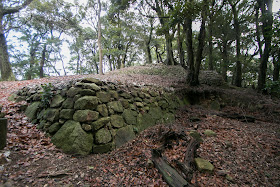



















































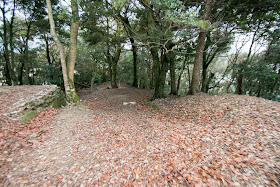













































































































































































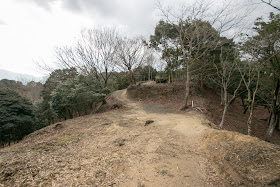


















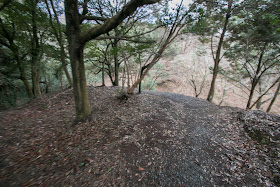












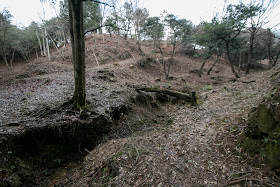













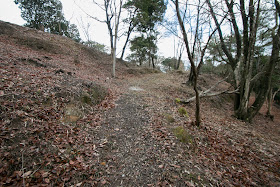













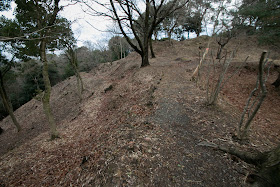


















































No comments:
Post a Comment